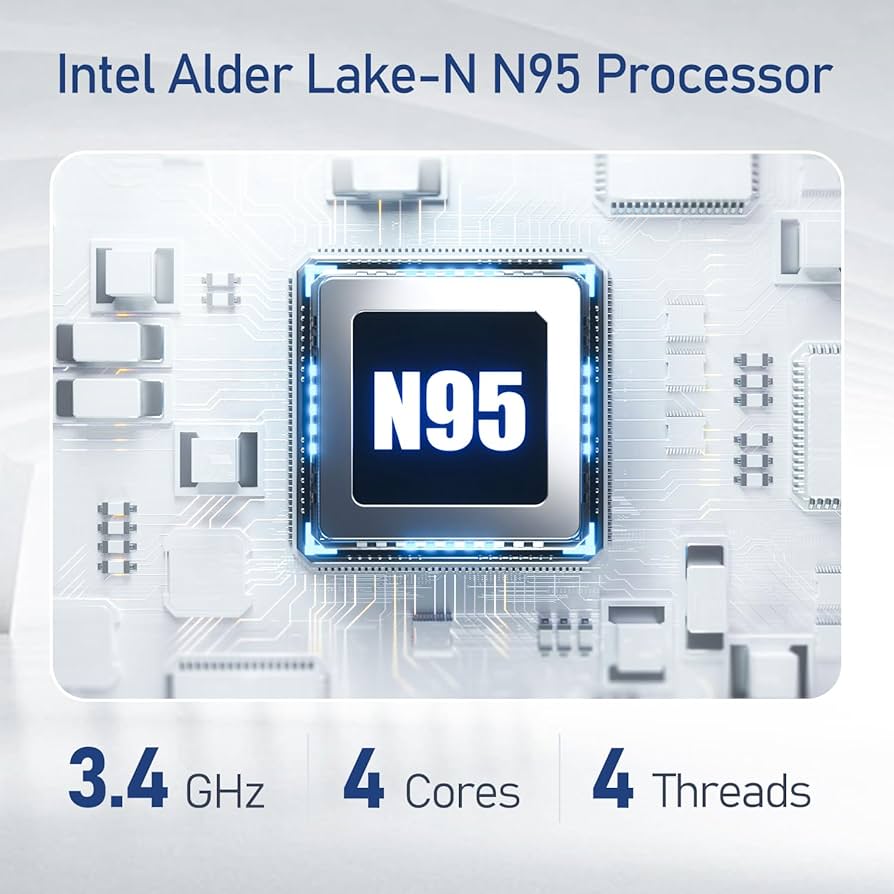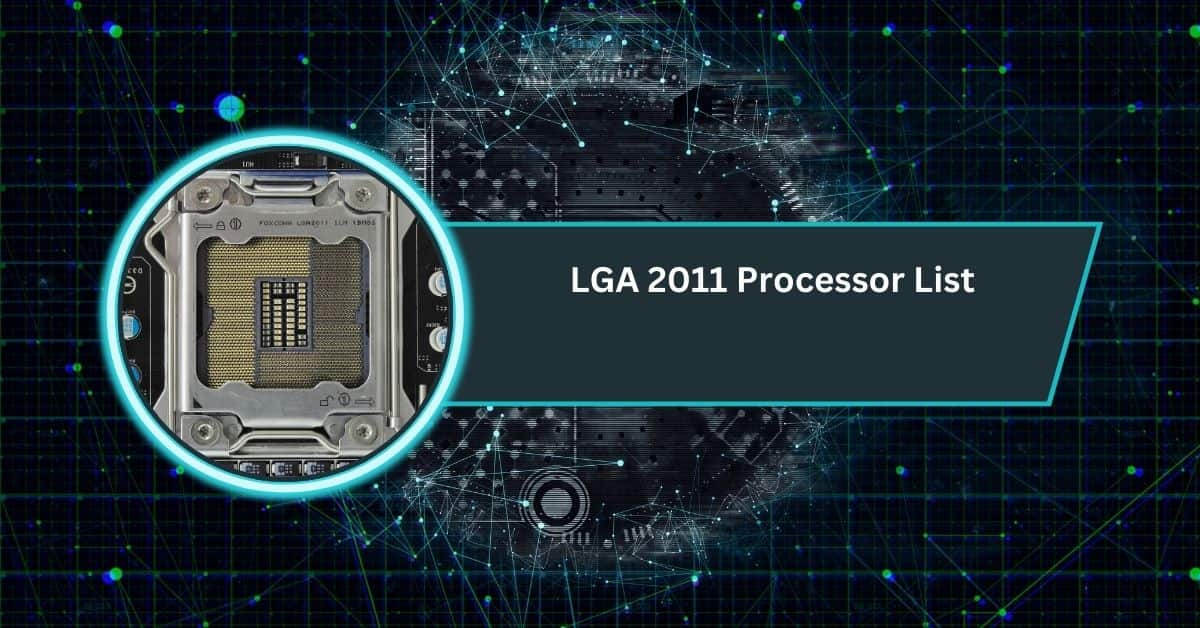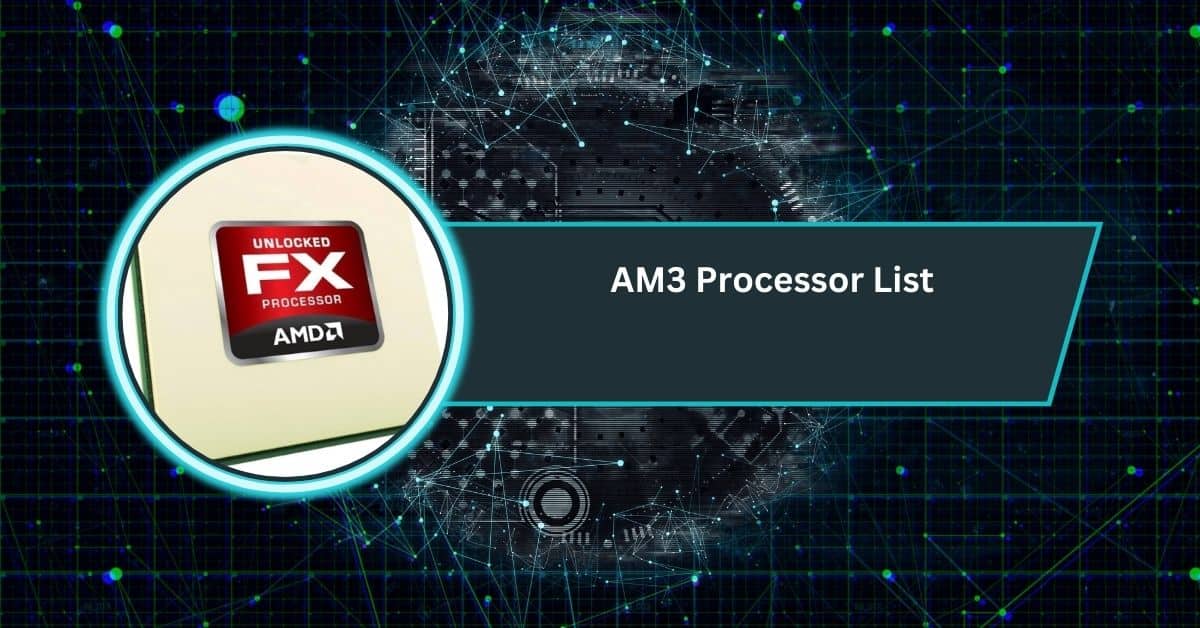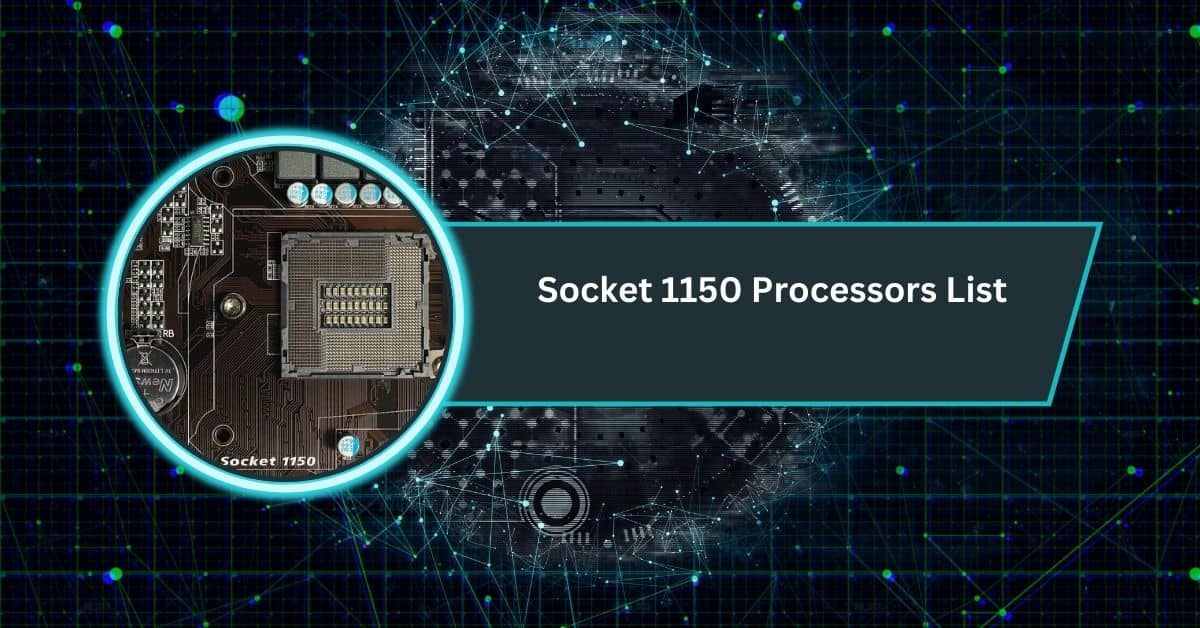Hey there! If you’re curious about the Intel N95 processor and what matches its vibe, you’re in the right place. This budget-friendly chip powers affordable laptops and mini PCs, perfect for everyday stuff like browsing, streaming, or schoolwork.
The Intel N95 processor is equivalent to the Intel Celeron N5105, Pentium N6000, and AMD Athlon Gold 7220U, offering similar performance for budget laptops and mini PCs.
In this guide, we’ll break down processors from Intel and AMD that are close equivalents, focusing on what’s available in the USA. Whether you’re shopping for a cheap device or just want to know your options, we’ll keep it simple and clear, comparing performance, price, and what these chips can handle for you.
Understanding the Intel N95 Processor
The Intel N95, part of the Alder Lake-N series released in 2023, is a quad-core processor without hyper-threading, meaning it has four cores and four threads.
It has a base clock speed of around 1.7 GHz, with a turbo boost up to 3.4 GHz, and a thermal design power (TDP) of 15W, making it ideal for energy-efficient devices like Chromebooks, tablets, and mini PCs.
It includes Intel UHD Graphics (24 execution units, up to 750 MHz), suitable for basic graphics tasks like video streaming and casual gaming.
The processor supports DDR4 and DDR5 memory and is built on Intel’s 10nm process. Its L3 cache is 6 MB, and it’s designed for fanless or minimal-cooling systems, prioritizing efficiency over raw performance.
The N95 is commonly found in devices like the Beelink Mini S12, ASUS Chromebook CX1, and other budget-friendly systems priced between $150 and $300 in the U.S. market.
Its performance is sufficient for web browsing, video conferencing, streaming (up to 4K with hardware decoding), and basic productivity tasks like word processing or spreadsheets. However, it struggles with demanding workloads like video editing, 3D rendering, or modern gaming.
Criteria for Equivalent Processors

To find equivalents, we’ll look for processors with:
- Similar core and thread counts (quad-core, 4-8 threads).
- Comparable clock speeds (base around 1.5-2.0 GHz, boost up to 3.0-3.6 GHz).
- Low TDP (10-15W) for energy efficiency.
- Integrated graphics performance close to Intel UHD Graphics.
- Similar use cases (budget laptops, mini PCs, light productivity).
- Availability in the U.S. market with competitive pricing.
We’ll compare Intel’s own processors and AMD’s offerings, as AMD is the primary competitor in this segment. Other brands like Qualcomm (Snapdragon) or MediaTek are less relevant for direct PC comparisons in the U.S.
Intel Processor Equivalents
- Intel Celeron N5105 (Jasper Lake, 2021)
- Specs: Quad-core, 4 threads, 2.0 GHz base, 2.9 GHz turbo, 10W TDP, Intel UHD Graphics (24 EUs, up to 800 MHz), 10nm process, 4 MB L3 cache.
- Comparison: The N5105 is a predecessor to the N95, with a slightly higher base clock but lower turbo speed. Its graphics performance is nearly identical, and it’s also used in budget mini PCs and laptops. The N5105 is slightly less efficient due to its older architecture but offers comparable performance for web browsing and streaming.
- Use Case: Found in devices like the Beelink U59 and budget Chromebooks, it’s a close match for the N95 in price ($150-$250 devices) and performance.
- Availability: Widely available in the U.S. through retailers like Amazon and Newegg.
- Intel Core i3-N305 (Alder Lake-N, 2023)
- Specs: 8 cores, 8 threads, 1.8 GHz base, 3.8 GHz turbo, 15W TDP, Intel UHD Graphics (32 EUs, up to 1.25 GHz), 10nm process, 6 MB L3 cache.
- Comparison: The i3-N305 is a step above the N95, with double the cores and threads, slightly higher boost clocks, and better integrated graphics. It’s overkill for basic tasks but offers better multitasking and slightly improved graphics for casual gaming. Its TDP remains 15W, maintaining efficiency.
- Use Case: Found in slightly higher-end budget laptops (e.g., Acer Aspire 3, $300-$400), it’s a premium alternative for users needing more power without leaving the budget segment.
- Availability: Common in U.S. retail, though pricier than N95-based systems.
- Intel Pentium Silver N6000 (Jasper Lake, 2021)
- Specs: Quad-core, 4 threads, 1.1 GHz base, 3.3 GHz turbo, 10W TDP, Intel UHD Graphics (32 EUs, up to 850 MHz), 10nm process, 4 MB L3 cache.
- Comparison: The N6000 has a lower base clock but a similar boost clock to the N95. Its graphics are slightly better, and it’s equally efficient. Performance is nearly identical for most tasks, though the N95’s newer architecture gives it a slight edge in single-threaded tasks.
- Use Case: Used in budget laptops and mini PCs (e.g., Lenovo IdeaPad 1), it’s a direct competitor in the $150-$250 price range.
- Availability: Readily available in the U.S., especially in refurbished or budget systems.
AMD Processor Equivalents
- AMD Athlon Silver 3050U (2020)
- Specs: Dual-core, 4 threads, 2.3 GHz base, 3.2 GHz turbo, 15W TDP, AMD Radeon Graphics (2 cores, ~1 GHz), 14nm process, 4 MB L3 cache.
- Comparison: The 3050U has fewer cores but supports hyper-threading, matching the N95’s thread count. Its base clock is higher, but the boost is slightly lower. Graphics performance is weaker due to fewer GPU cores, but it’s sufficient for basic tasks. The older 14nm process makes it less efficient than the N95.
- Use Case: Found in budget laptops like the HP 14 ($200-$300), it’s suitable for web browsing and light productivity but may lag in multitasking compared to the N95.
- Availability: Available in the U.S., though less common in mini PCs than Intel options.
- AMD Ryzen 3 7320U (Mendocino, 2022)
- Specs: Quad-core, 8 threads, 2.4 GHz base, 4.1 GHz turbo, 15W TDP, AMD Radeon 610M (2 cores, up to 1.9 GHz), 6nm process, 4 MB L3 cache.
- Comparison: The Ryzen 3 7320U outperforms the N95 with higher clock speeds, more threads, and a more efficient 6nm process. Its graphics are better for light gaming (e.g., older titles like Minecraft), and it handles multitasking better due to hyper-threading. However, it’s pricier, appearing in $300-$450 laptops.
- Use Case: Found in budget gaming laptops and mid-range Chromebooks (e.g., Acer Chromebook 516 GE), it’s a stronger alternative for users willing to spend more.
- Availability: Widely available in the U.S. through major retailers.
- AMD Athlon Gold 7220U (Mendocino, 2022)
- Specs: Dual-core, 4 threads, 2.4 GHz base, 3.7 GHz turbo, 15W TDP, AMD Radeon 610M (2 cores, up to 1.9 GHz), 6nm process, 4 MB L3 cache.
- Comparison: Similar to the Ryzen 3 7320U but with two cores, it matches the N95’s thread count and offers higher boost clocks. Its graphics are superior for light gaming, and the 6nm process improves efficiency over older AMD chips. It’s slightly more powerful than the N95 for single-threaded tasks.
- Use Case: Used in budget laptops like the Lenovo IdeaPad Slim 3 ($250-$350), it’s a good alternative for users needing better graphics performance.
- Availability: Available in the U.S., particularly in newer budget laptops.
Performance Comparison
To quantify equivalence, let’s compare benchmark scores (e.g., PassMark CPU Mark, based on web data):
- Intel N95: ~5,500 (multi-thread), ~2,000 (single-thread).
- Intel Celeron N5105: ~5,200 (multi-thread), ~1,800 (single-thread).
- Intel Core i3-N305: ~12,000 (multi-thread), ~2,500 (single-thread).
- Intel Pentium Silver N6000: ~5,300 (multi-thread), ~1,900 (single-thread).
- AMD Athlon Silver 3050U: ~4,800 (multi-thread), ~1,700 (single-thread).
- AMD Ryzen 3 7320U: ~9,000 (multi-thread), ~2,300 (single-thread).
- AMD Athlon Gold 7220U: ~5,800 (multi-thread), ~2,100 (single-thread).
The N95’s closest matches are the Celeron N5105, Pentium Silver N6000, and Athlon Gold 7220U, with similar multi-threaded performance. The Ryzen 3 7320U and Core i3-N305 are stronger but pricier, while the Athlon Silver 3050U is slightly weaker.
Use Case Suitability
- Web Browsing/Streaming: All processors handle 1080p streaming well, with the N95, N5105, N6000, and 3050U being nearly identical. The Ryzen 3 7320U and i3-N305 support 4K streaming with less stuttering.
- Productivity: The N95 is adequate for Google Docs or Microsoft Office. The Ryzen 3 7320U and i3-N305 excel in multitasking (e.g., multiple browser tabs and apps).
- Light Gaming: The N95 and N6000 can run older games (e.g., League of Legends at low settings, ~30-40 FPS). The Ryzen 3 7320U and Athlon Gold 7220U are better for casual gaming due to stronger graphics.
- Battery Life: All have 10-15W TDP, offering 8-12 hours in budget laptops, with AMD’s 6nm chips (7220U, 7320U) slightly more efficient.
Pricing and Availability in the USA
- N95 Devices: $150-$300 (e.g., Beelink Mini S12, $199 on Amazon).
- Celeron N5105: $150-$250 (e.g., Beelink U59, $179).
- Pentium N6000: $150-$250 (e.g., Lenovo IdeaPad 1, $229).
- Core i3-N305: $300-$400 (e.g., Acer Aspire 3, $349).
- Athlon Silver 3050U: $200-$300 (e.g., HP 14, $249).
- Ryzen 3 7320U: $300-$450 (e.g., Acer Chromebook, $399).
- Athlon Gold 7220U: $250-$350 (e.g., Lenovo IdeaPad Slim 3, $299).
Prices reflect U.S. retail as of May 2025, based on Amazon, Newegg, and Walmart listings. The N95, N5105, and N6000 are the most budget-friendly, while the Ryzen 3 7320U and i3-N305 are mid-range options.
Recommendations for U.S. Consumers
- Best Budget Match: Intel Celeron N5105 or Pentium Silver N6000 for near-identical performance at the lowest cost. Ideal for students or casual users buying mini PCs or Chromebooks under $250.
- Best Value Upgrade: AMD Ryzen 3 7320U for better multitasking and gaming in $300-$400 laptops. Great for users needing a bit more power without breaking the bank.
- Best Performance in Segment: Intel Core i3-N305 for superior multitasking and graphics in $350-$400 devices, suitable for small business or power users on a budget.
Conclusion
The Intel N95 is a solid entry-level processor for budget-conscious U.S. consumers. Its closest equivalents are the Intel Celeron N5105, Pentium Silver N6000, and AMD Athlon Gold 7220U, offering similar performance for basic tasks. For those willing to spend more, the AMD Ryzen 3 7320U and Intel Core i3-N305 provide better performance for multitasking and light gaming. When choosing, consider your device (laptop vs. mini PC), budget, and whether you prioritize efficiency or slightly better performance.
FAQs
What is the Intel equivalent of the N95 processor?
Celeron N5105 and Pentium N6000 are Intel equivalents to the N95, offering similar performance for budget laptops and mini PCs.
What generation is the Intel N95?
The Intel N95 is part of the 12th generation Alder Lake-N series, released in 2023 for budget-friendly, low-power devices.
Is the Intel N95 a good processor?
The Intel N95 is good for basic tasks like browsing, streaming, and light work, but not for gaming or heavy multitasking.
Is the Intel N95 better than the i5?
No, the Intel N95 is not better than i5 processors; i5s are faster and handle demanding tasks like gaming and editing.
Is the Intel N95 better than the i3?
The Intel N95 is not better than i3 processors; i3s offer more cores and better performance for multitasking and gaming.











